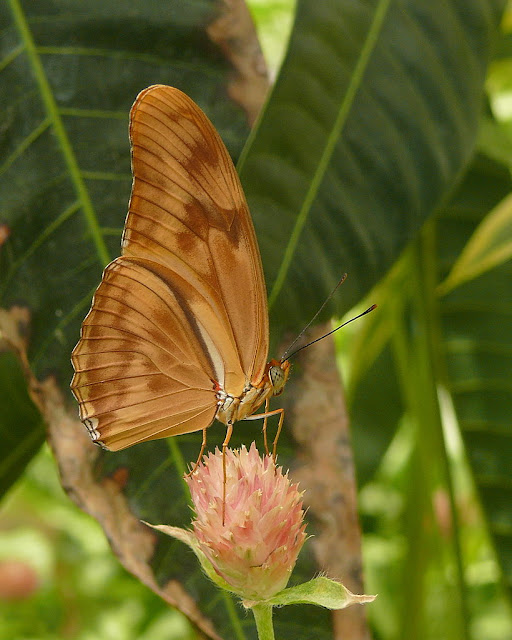Summary: Dryas iulia is a large New World butterfly with flame orange coloring and a passion for lachryphagous, or tear sipping, behavior, especially with reptiles.
 |
| Julia butterfly (Dryas iulia), Butterflies Alive!, Santa Barbara Museum of Natural History, Mission Canyon suburb, Santa Barbara, Santa Barbara County, Southern California; Saturday, June 21, 2014, 10:29:52: Dawn Beattie (Pets4Dawn), CC BY 2.0 Generic, via Flickr |
Dryas iulia is a New World butterfly native to North, Central, and South America. Dryas iulia claims homelands from Brazil northward into Guyana and Suriname and northwestward across South and Central America into Mexico and South Texas as well as across the West Indies into the Florida Keys and peninsular Florida.
Migratory Dryas iulia sometimes stray beyond Texas as far north as Nebraska.
Dryas iulia is known commonly in English as Flambeau, the Flame, Julia, Julia Heliconian or Julia Longwing.
The common names of Julia Heliconian and of Julia Longwing reflect Dryas iulia's membership in the Heliconiinae, a butterfly subfamily characterized by tipward elongation of forewings.
As a fast flier with a preference for clearings, edges, and openings, Julia butterflies especially seek fields, hardwood hammocks, and riversides.
Dryas iulia favors passion vines (Passiflora spp.) as host plants for their caterpillars. Nine of the world's 500 species of Passiflora are native to the United States.
Julia butterflies especially enjoy lantanas (Lantana spp.), also known as shrub verbenas, and passion vines as nectar sources. In the United States, purple passionflower (Passiflora incarnata), native from Texas eastward through Florida, exemplifies the allure of passion vines for Dryas iulia's entire life cycle, from larva to butterfly.
Orange with brown-to-black borders and markings characterize Julia’s uppersides, with males characteristically presenting more vivid shades than females’ subdued oranges.
Undersides display remarkable, albeit subdued, shades of orange and brownish orange.
 |
| undersides, or ventral view, of Julia butterfly, Irwin M. Krohn Conservatory, Eden Park, near eastern Cincinnati, southwestern Ohio; Tuesday, May 26, 2009, 13:39: Greg Hume, CC BY SA 3.0 Unported, via Wikimedia Commons |
As a large member of the medium-to-large Nymphalidae, or brush-footed, family, Julia butterflies open their wings to spans of 3 ¼ to 3 5/8 inches (8.2 to 9.2 centimeters).
As brush-footed butterflies, Dryas iulia appear to have only four legs because their diminutive pair of forelegs, covered like a hair brush with short bristles, are often not noticeable.
Julia butterflies join other insects, including bees and other butterflies, in engaging in lachryphagy (Latin: lacrima, “tear”; Ancient Greek: δάκρυον, dákruon, “tear”+ -φαγία, -phagía, combining form of φαγεῖν, phageîn, “to eat”). Insects drink, sip or suck tears in order to extract essential nutrients, such as protein and sodium, from the saline, watery fluids released by tear ducts or salt glands around the eyes, mouth or nostrils of mammals or reptiles.
As enthusiastic tear sippers, Julia butterflies engage in the beneficial behavior especially with such basking reptiles as the spectacled caiman (Caiman crocodilus) of Mexico and Central and South America and South American river turtles (Podocnemis spp.) of tropical South America. Tear-sipping occurrences between Julia butterflies and their reptilian hosts tend to convey the mesmerizing harmony of Nature's mysterious rhythms to human viewers who observe such fortunate happenstances.
 |
| Julia butterflies (Dryas iulia) drink tears of South American river turtles (Podocnemis spp.) in Ecuador; Thursday, Sep. 27, 2012, 13:35: amalavida.tv, CC BY SA 2.0 Generic, via Wikimedia Common |
Acknowledgment
My special thanks to talented artists and photographers/concerned organizations who make their fine images available on the internet.
Image credits:
Image credits:
Julia butterfly (Dryas iulia), Butterflies Alive!, Santa Barbara Museum of Natural History, Mission Canyon suburb, Santa Barbara, Santa Barbara County, Southern California; Saturday, June 21, 2014, 10:29:52: Dawn Beattie (Pets4Dawn), CC BY 2.0 Generic, via Flickr @ https://www.flickr.com/photos/pics4dawn/14327700100/
undersides, or ventral view, of Julia butterfly, Irwin M. Krohn Conservatory, Eden Park, near eastern Cincinnati, southwestern Ohio; Tuesday, May 26, 2009, 13:39: Greg Hume, CC BY SA 3.0 Unported, via Wikimedia Commons @ http://commons.wikimedia.org/wiki/File:DryasJulia-Ventral.jpg
Julia butterflies (Dryas iulia) drink tears of South American river turtles (Podocnemis spp.) in Ecuador; Thursday, Sep. 27, 2012, 13:35: amalavida.tv, CC BY SA 2.0 Generic, via Wikimedia Common @ http://commons.wikimedia.org/wiki/File:A_butterfly_feeding_on_the_tears_of_a_turtle_in_Ecuador.jpg
For further information:
For further information:
Beltrán, Margarita, and Andrew V.Z. Brower. “Dryas Huebner 1807, Dryas iulia (Fabricius 1775).”Tree of Life Web Project. Version 04 Sept. 2008.
Available @ http://tolweb.org/Dryas_iulia/70435
Available @ http://tolweb.org/Dryas_iulia/70435
Birsa, Tanea. “Discover the tear drinkers – Nature is a wonderful Recycler!” WikiGag > Wiki. May 3, 2014.
Available @ http://wikigag.com/discover-the-tear-drinkers-nature-is-a-wonderful-recycler/
Available @ http://wikigag.com/discover-the-tear-drinkers-nature-is-a-wonderful-recycler/
“Julia Heliconian Dryas iulia (Fabricius, 1775).”Butterflies and Moths of North America > Species.
Available @ http://www.butterfliesandmoths.org/species/Dryas-iulia
Available @ http://www.butterfliesandmoths.org/species/Dryas-iulia
Máca, Jan, and Domenico Otranto. “Drosophilidae feeding on animals and the inherent mystery of their parasitism.” Parasites and Vectors, vol. 7 (Nov. 18, 2014): 516-523.
Available via BioMed Online @ http://www.biomedcentral.com/content/pdf/s13071-014-0516-4.pdf
Available via Parasites & Vectors @ http://www.parasitesandvectors.com/content/7/1/516
Available via BioMed Online @ http://www.biomedcentral.com/content/pdf/s13071-014-0516-4.pdf
Available via Parasites & Vectors @ http://www.parasitesandvectors.com/content/7/1/516
Raloff, Janet. "These insects thirst for tears." Student Science > Science News for Students > Article. May 1, 2014.
Available @ https://student.societyforscience.org/article/these-insects-thirst-tears?mode=topic&context=91
Available @ https://student.societyforscience.org/article/these-insects-thirst-tears?mode=topic&context=91
Sirucek, Stefan. “Why Butterflies, Bees Drink Crocodile Tears.” National Geographic > Voices > Weird & Wild. May 7, 2014.
Available @ http://voices.nationalgeographic.com/2014/05/07/insects-tears-feed-science-environment-animals/
Available @ http://voices.nationalgeographic.com/2014/05/07/insects-tears-feed-science-environment-animals/
No comments:
Post a Comment
Note: Only a member of this blog may post a comment.